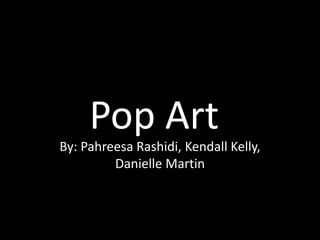
Pop art
- 1. Pop Art By: Pahreesa Rashidi, Kendall Kelly, Danielle Martin
- 2. In General • Started as a rebellion against Abstract Expressionism • All about making images into works Americans could identify with • Roots in Dadaism • British pop art was less critical, expressing a more romantic view of the subject matter
- 3. In the Car-1963, Roy Lichtenstein
- 4. Still Life #12-1962, Tom Wesselmann
- 6. Equality 210 Coca-Cola Bottles- 1962, Andy Warhol
- 7. Different from previous art movements, Abstract Expressionism Pop Art • Emotion • Representational • Considered “high art” • Relatable • Subject was the • Subjects were objects from unconscious and thus life, events, culture subjective in nature • Ironic and mocking • Serious • Mimics mechanical means • Dynamic gestures, elements of production of chance • Originally rejected and • Accepted by the “academy” heavily criticized
- 8. Historical Context • Mid 50’s and throughout the 60’s • World War ll had just ended • Cold War and then the Vietnam War • Economic boom led to mass consumerism • Television became a part of every home • “Keeping up with the Jones’” • America became covered with chain and fast food restuarants
- 11. Two Subjects Where does Capitalism fit in? Glamour Dark side • Stars • Poverty • Commodities • Violence • The “American Dream” • War • Materialism
- 12. 300 SL Coupe-1954, Andy Warhol
- 14. Floor Burger- 1962, Claes Oldenburg
- 15. Lipstick (Ascending) on Caterpillar Tracks- 1969-1974, Claes Oldenburg
- 16. Techniques • Silk-screen printing- consists of mechanical repetition of images while reducing them to its essential outlines • Impasto-Building up thick layers of paint • Airbrushing-To make photo-like paintings • Dot painting-Created Benday dots using a metal stencil and carefully painting through the regularly spaced holes of the Benday screen onto the canvas.
- 17. Silk-screen print example Marilyn Monroe-1962, Warhol
- 18. Roy Lichtenstein • Used comic books, cartoons and advertisements for inspiration • Mostly primary color palette • Dark lines and hard edges • Benday dots • Large Scale • Admired and influenced by Pablo Picasso, Paul Cezanne and Paul Klee
- 19. Magnifying Glass- 1963, Roy Lichtenstein
- 20. Look Mickey-1961, Roy Lichtenstein
- 21. Reflections, Art-1988, Roy Lichtenstein
- 22. Drowning Girl-1963, Roy Lichtenstein
- 24. On the Right: Comic Book Panel from Steve Roper, August 6, 1961, by William Overgard On the Left: I can see the whole room… and there’s nobody in it!- 1962, Roy Lichtenstein
- 25. White Brushstroke-1965, Roy Lichtenstein
- 26. Andy Warhol • “Prince of pop” • Known for using movie stars • Transformed icons • Silk-screen printing
- 27. Campbell’s Soup Can-1962, Warhol
- 28. Brillo Box-1970, Warhol Brillo Boxes- 1970, Andy Warhol
- 30. Liz #5-1963, Andy Warhol
- 31. Mickey Mouse 2-1981, Warhol
- 32. Richard Hamilton • Is the father of pop art. • He painted and made collages • Became friends and was inspired by Duchamp.
- 33. “Just what is it that makes today’s home’s so different, so appealing.” (1956)
- 35. Jasper Johns • Used symbols, numbers and signs • Wanted to draw attention to common objects • Plays with meaning • Bold colors • Wanted to keep his work independent of the movement
- 37. Target- 1974, Jasper Johns
- 38. Numbers in Color-1959, Jasper Johns
- 39. Robert Rauschenberg • “Paintings look more like real life if they are composed from the elements of real life”. • Integration • Hybrid between painting and sculpture= combines • Sculptures vs. paintings • Messy style • Collages
- 40. Retroactive ll-1964, Robert Rauscenberg
- 41. Expulsion of Adam and Eve from the Garden of Eden-1432-Masaccio’s
- 45. Features from currents #62-1970, Robert Rauschenberg
- 46. Claes Oldenburg • He went through different styles of art. • He mostly created sculptures. He took a ordinary object and change its context. • He wanted the viewer to stop and think about his sculptures. • He wanted his art to relate to the real world. • He was strongly influenced by Sigmund Freud. • The materials for soft sculptures: paper, canvas plaster and chicken wire, then later on vinyl, Formica, and Plexiglas.
- 47. Spoonbridge and Cherry-1985-1988, Claes Oldenburg
- 48. Lipstick (Ascending) on Caterpillar Tracks- 1969-1974, Claes Oldenburg
- 49. Floor Burger- 1962, Claes Oldenburg
- 50. French Fries and Ketchup-1963, Claes Oldenburg
- 51. The End